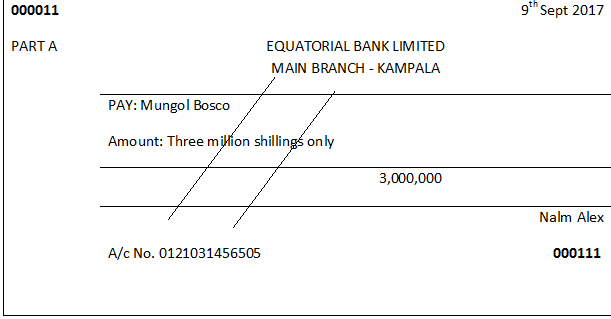1. The unit of a loan to a public limited company is known as
A. stock
B. debenture
C. mortgage
D. share
2. Which principle of co-operatives states that each member must have only one vote regardless of the number of shares?
A. Limited interest on share capital
B. Open and voluntary membership
C. Dividend or repayment
D. Democratic administration.
3. The re-exportation of goods which were previously imported is referred to as
A. entrepôt trade
B. bi-lateral trade
C. internal trade
D. multi-lateral trade
4. What act is used by the government of Uganda to protect consumers from buying inferior goods?
A. Weights and Measures Act.
B. Trade Descriptions Act.
C. Sale of Goods Act.
D. Food and Drugs Act.
5. Identify the order in which human wants are satisfied.
A. Consumption, Commerce, Production.
B. Production, Commerce, Consumption.
C. Consumption, Production, Commerce.
D. Commerce, Production, Consumption.
6. The reward for the human effort used in the production of goods and services is called?
A. rent
B. interest
C. wage
D. profit
7. The quantity of a commodity an individual is willing and able to but at a given price in a given period time is referred to as
A. demand
B. consumption
C. production
D. supply
8. The method of payment where the buyer sends money for the goods on ordering for them is known as
A. cash on delivery
B. prompt cash
C. spot cash
D. cash with order.
9. Which of the following documents does a seller send to remind the buyer of the amount due?
A. Bill of exchange
B. Credit note
C. Statement of account
D. Debit note
10. When a country sells goods to a foreign country at prices that are lower than prices in the home market, this practice is called
A. devaluation
B. smuggling
C. customs drawback
D. dumping
11. The transfer of ownership of state enterprises to individuals and firms is known as
A. centralisation
B. privatization
C. delocalization
D. nationalization
12. Ships that carry goods from anywhere without following a fixed route and timetable are called
A. tramp steamers
B. tankers
C. marine ships
D. cargo liners
13. A business that continues operating when the value of its assets is lower than its liabilities is said to be
A. bankrupt
B. insolvent
C. solvent
D. liquidated
14. Which insurance policy is only responsible for compensating a pedestrian knocked by a speeding car but not the car owner?
A. Comprehensive
B. Endowment
C. Third party
D. Fidelity guarantee
15. The interest which the Central Bank charges on short term loans lent to commercial banks is known as
A. cash ratio
B. bank rate
C. special deposits
D. discount rate
16. Which of the following types of warehouses enables Uganda Revenue Authority to collect import duty?
A. Bonded warehouse
B. Public warehouse
C. Wholesale warehouse
D. Private warehouse
17. Determine a trader’s margin given turnover Shs20,000,000, cost of sales Shs 12,000,000 and net profit Shs2,000,000
A. 66.7%
B. 50%
C. 40%
D. 30%
18. The amount charged by the Post Office for its postal orders is termed as
A. interest
B. demurrage
C. commission
D. poundage
19. Choose the aids to trade that aims at finding out the opinion of the public about a particular product.
A. Communication
B. Advertising
C. Transport
D. Market research.
20. Identify the tax which is levied on locally manufactured goods
A. Excise duty
B. Import duty
C. Rental tax
D. Pay As You Earn
21. a) Differentiate between localization and delocalization of industries.
b) Give five advantages and three disadvantages of delocalization of industries.
22. a) Outline any five contents of an order as a business document.
b) Explain to a wholesaler any five sources of information about the credit worthiness of a retailer wishing to buy goods on credit.
c) State five circumstances under which a wholesaler may issue a credit note to the retailer.
23. a) Give eight reasons why Uganda trades with other countries.
b) Explain six problems faced by Uganda when trading with other countries.
24. Study the following specimen of a cheque and answer the questions that follow.

a) Name the:
i) Drawer
ii) Payee
iii) Drawee
iv) Part ndented A
b) State the purpose of :
i) part A
ii) the crossings in the cheque
c) Explain six advantages of using cheques as means of payment to traders
25. a) Describe the elements of a good transport sytem.
b) i) Identify a suitable mode of transport for each of the following commodities:
I. Milk from Mbarara to Masaka
II. Diamond from South Africa to the United states of America
III. Containers from Japan to Mombasa port
IV. Water from lake Victoria to Kampala city
ii) Give two reasons for the choice of each of the modes of transport mentioned in 25(b) (i) above.
26. a) Describe any five features of a good warehouse.
b) State any five roles of each of the following departments of warehouse:
i) Secretary’s Department.
ii) Accounts Department
27. a) Explain any six qualities of a good tax system.
b) Give eight reasons why the government of Uganda collects taxes.
28. a) Identify any four sources of capital for a small-scale retail business.
b) The following information was obtained from M. Okello’s retail business for the period ending 31st December 2016.
| Shs | |
| Purchases Returns inwards Opening stock (01.01.2016) Returns outwards Slaes Closing stock (31.12.2016) Expenses |
680,000 60,000 144,000 52,000 1,280,000 72,000 218,000 |
Calculate:
i) Average stock
ii) Cost of Sales
iii) Gross profit
iv) Net Profit
v) Mark-Up
Purchases
Returns inwards
Opening stock (01.01.2016)
Returns outwards
Slaes
Closing stock (31.12.2016)
Expenses
